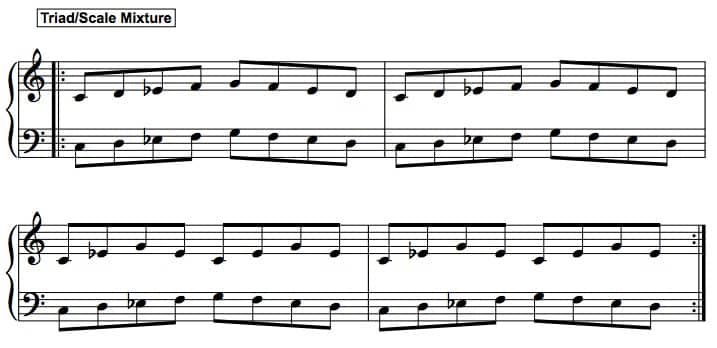Piano Technique is one of the the most important foundational elements that we all must learn, master and continue to practice, no matter what level of musician we are. This means even as a professional, we continually have to work on our piano technique.
A lot of students think piano technique is playing boring piano scales or piano arpeggios, but in reality it can be quite fun.
In this article I’m going to share with you a couple of piano technique exercises that will add some creativity to your piano practice routine.
Piano Chords Exercise – Triads & Scales
This piano exercise mixes 5-finger scales along with triad arpeggios. To see this in action, check out this Piano Chords Exercise video on YouTube.

Tetra Chords Exercise for Piano Technique
OK, so what is a tetrachord? You can read the Wikipedia article on tetrachords here. Basically, a tetrachord is 4 pitches (notes) that happen within a perfect 4th.
This translates into a 4-note scale in which all of the notes are within a perfect fourth interval. Now, in reality, we can use the tetrachord terminology a little looser to refer to any 4-note scale.

This two-handed tetra scale exercise is an incredible tool for increasing your fluidity and coordination between your hands. This piano technique exercise also helps you strengthen your left-hand because you are leaving out your thumb. When you play a 5-finger scale, and each finger plays a note, your hand gets used to this pattern. By removing one of the notes, you’ve made it more difficult to play this scale.
Piano Technique – 1-Week Practice Challenge
Want a challenge? Try this 7-day practice challenge to jumpstart your piano practice routine.
- Day 1 – play your major and minor 5-finger scales with the metronome on 80bpm. Focus on keeping the fingers together between the hands, don’t rush, breath and stay loose! Remain active. Do not “space out” when practicing this.
- Day 2 – move between playing a major or minor 5-finger scale, then play the corresponding triad arpeggio. For example, play a C major 5-finger scale up and down, then play the C major triad arpeggio up and down. Repeat 20x, slowly with a metronome on 80bpm. Move this exercise to 3 new keys.
- Day 3 – focus on transposing exercises from day 1 and 2 into 6 keys. Again, play with the metronome and stay loose.
- Day 4 – play the Two-Handed Tetra Scales exercise. Practice without the metronome to start. Instead, focus on keeping an even tone between each finger. One finger should not sound louder than any other finger. Also try to keep a very steady beat between EACH note.
- Day 5 – transpose the Two-Handed Tetra Scales exercise into 6 new keys. Now add the metronome on 80bpm.
- Day 6 – transpose both exercises into any key that you have not yet practiced.
- Day 7 – increase the metronome to 90bpm. Play exercises in contrary motion. Try playing in (2) different keys simultaneously.

